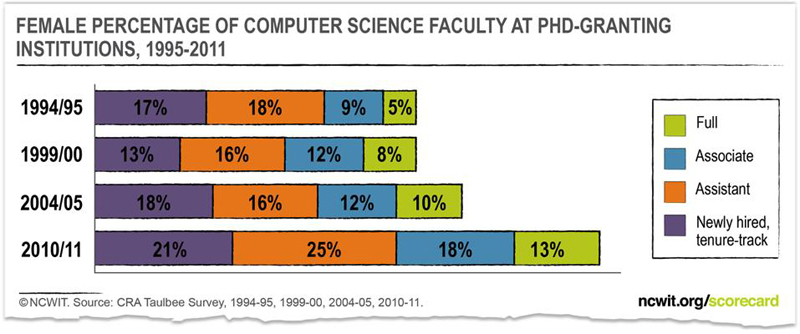The NCWIT Scorecard: A Report on the Status of Women in Information Technology
In the last 10 years, the computing community has started paying more attention to the lack of gender diversity in the field. There have been myriad programs introduced to amend the problem, including awareness-raising campaigns, out-of-school and in-school courses, workshops, and camps. At the national level, there are policy movements to include computer science as a high school graduation requirement, new recruitment practices and other organizational reforms introduced at the university and industry levels, and more. Many of these movements have been evaluated, and many have shown promise that they have, or will, make a difference in their local context. However, to understand whether or not all of these interventions, taken together, have actually “moved the needle,” we need to review the longitudinal data. How have girls’ and women’s representation in computing at the various levels changed, if at all, over time? And are we seeing any positive trends?
To scan the entire “pipeline” over time requires pulling data from a variety of different sources. Some of these sources are hard-to-find, available only upon custom order, or indecipherable to the average reader. The National Center for Women & Information Technology (NCWIT) collects these different statistics in a single, multi-section resource called The NCWIT Scorecard. The Scorecard provides a snapshot of illustrative statistics about the participation of girls and women in computing from K-12 through the workforce, all available for free download from the NCWIT website.
The Scorecard consists of a series of PowerPoint slide decks for each “segment” of the pipeline, and professionally designed statistical charts (each of which is downloadable as an individual .jpeg file). The PowerPoint files are presentation-ready, with “speaker notes” to assist, and the charts can be dropped easily into presentations, reports, or proposals. In addition, the entire Scorecard can be downloaded or printed as a PDF for easy reference or sharing with colleagues.
Information about the Entire Pipeline
The NCWIT Scorecard includes six distinct sections:
- Why Gender Diversity is Important to Computing
- Why Computing is a Good Career for Women
- Secondary Education
- Post-Secondary Education
- Workforce
- Thought Leadership & Innovation
Each section contains the latest relevant statistics, as well as ways readers and audience members can take action to make a difference in that segment of the pipeline.
Why Gender Diversity is Important to Computing
To ensure a common starting point for discussing the diversification of the computing field, the Scorecard begins with research-based reasons for why it is important to have diversity of thought and background. While many people are swayed by the moral arguments for gender equity in educational and work environments, it is also important in many cases to present the “business case.” Five economic arguments are presented: expanding the qualified employee pool in the face of current and pending employee shortages, improving the bottom line, enhancing innovation, promoting social equality through technology, and reflecting the customer base.
Why Computing is a Good Career for Women
In NCWIT’s experience, advocates for gender diversity in computing also need a set of economic arguments for why computing is an excellent career choice for women (and men); therefore, an entire section of the Scorecard is devoted to presenting data that supports computing as a career choice. This section includes data on low unemployment in the industry, high salaries, and high predicted job growth. Importantly, computing is a field where the wage gap between men and women is smaller than in many other fields. A salary chart excerpted from the Scorecard is shown below.
The Secondary Education section of the Scorecard includes charts and narrative about the computing-related preparation and experience of high school students (male and female). While most K-12 students are not exposed to rigorous computing classes in middle or high school, the number of college-bound students reporting at least some programming experience is growing, as is the number of students taking the Computer Science (CS) Advanced Placement (AP) exam. Still, only 1% of all AP exam-takers take a CS AP, and consistently only 19% or fewer of those students have been female (see chart below).
This section also explains the reasons why computing education is lacking at the secondary level, including the fact that AP computer science is often classified in high school as an elective, putting it in competition with music and art electives. Links to evidence-based recruitment and engagement strategies, as well as talking points for pushing for policy change, give the reader concrete strategies for taking action.
In the Post-Secondary Education section, a number of charts highlight the dearth of women earning computing degrees compared to other STEM fields. The statistics cover two-year degrees, four-year undergraduate degrees, master’s and doctoral degrees. The degree completions are compared across time, and the degrees earned by women are broken down by race, ethnicity, and U.S. resident status. As can be seen in the chart below, until recently, other STEM disciplines have been on a fairly steady trajectory with regard to female participation. In comparison, computing has been uneven, but it has held steady for the past six years.
This section ends with a brief case study describing three undergraduate computing departments that successfully increased the number of female computing majors at their institutions: University of California at Irvine, Carnegie Mellon University, and University of Virginia.
Like the preceding two sections, the Workforce section of the Scorecard includes colorful charts, an easy-to-read narrative, a case study and many links to relevant resource materials. As a companion piece to the Post-Secondary section, it also contains data showing the relative percentages of women in the computing workforce and other science professions, and the racial/ethnic breakdown of women in the computing workforce. U.S. Bureau of Labor Statistics data show that certain occupational classifications within computing have higher representation of women than others. For example, a much higher percentage of women hold database administrator positions than hold software engineer positions.
Drawing from CRA Taulbee survey data, the Scorecard also depicts the percentage of women among computer science faculty at PhD-granting institutions from 1995 through 2012. The chart below shows that the female percentage of faculty has increased at all ranks since 1995.
Thought Leadership & Innovation
The final section of the Scorecard focuses on how diversity contributes to technical innovation. Because there is relatively little research conducted in this arena, three different indicators are used: research on female and mixed-gender team patenting trends, female PhD publishing trends, and the representation of women in open source computing. This section also includes many links to practical resources for increasing women’s contributions to thought leadership in computing.
How to Use the Scorecard
NCWIT’s hope in publishing the Scorecard is to provide interested stakeholders at every level in their respective organizations with the tools necessary to educate others about the representation and participation of females in computing at the various stages of the pipeline over the last several decades. NCWIT’s evaluation findings have suggested that sharing conclusive research and easy-to-understand data helps to convince people of the need for gender reform in the field. The Scorecard’s description of promising practices, practical advice, and case studies are all intended to drive awareness and action from substantive knowledge.
NCWIT welcomes comments on the Scorecard and suggestions for other data charts and research summaries that readers would find useful. Please send feedback to evaluation@ncwit.org.
Additional Research with Practical Applications to the Academic Environment
The NCWIT website contains over 100 research-based resources to help you understand and explain the need for gender diversity in computing, and then take action to accomplish the necessary systemic changes. Recent resources include a Program-in-a-Box for how to do outreach into high schools, as well as tips on how to engage students in computing, how to retain them once you have them, and how to identify male allies and increase men’s advocacy for reform. A selection of recent, relevant titles, include:
- Outreach: Roadshow-in-a-Box: Capitalizing on Models for Outreach
- Engagement: Top 10 Ways to Engage Underrepresented Students in Computing
- Recruitment: Strategic Planning for Recruiting Women into Undergraduate Computing: High Yield in the Short Term
- Retention: Key Practices for Retaining Undergraduates in Computing
- Male Allies: 8 Ways to Identify Male Advocates and 8 Ways to Increase Male Advocacy
Check out all the other materials available at www.ncwit.org/resources.
About the Author
Dr. Wendy DuBow is a senior research scientist at NCWIT. She is the author of The NCWIT Scorecard, a co-principal investigator on the male advocacy research, and co-creator of a new survey instrument that can be used to evaluate the impact of computing courses, camps and workshops on student engagement, self-efficacy, and intent to persist in the field. NCWIT is a non-profit, change-leader network of more than 450 corporations, academic institutions, government agencies, and non-profits working to increase women’s meaningful participation in computing. NCWIT helps organizations recruit, retain, and advance women from K-12 and higher education through careers.













